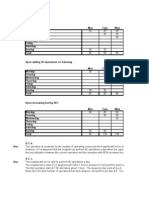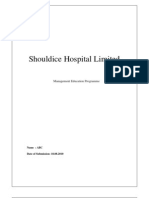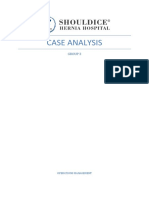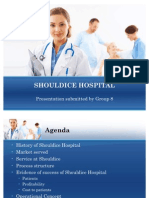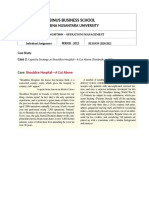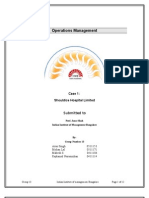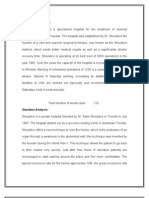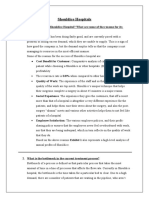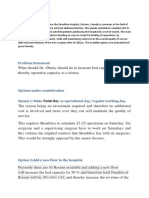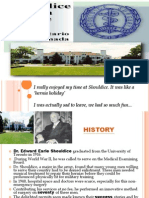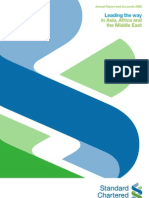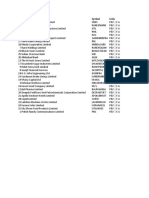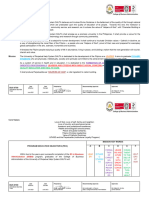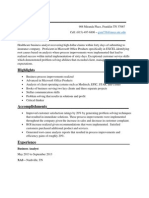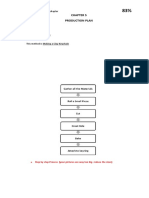Shouldice Hospital Limited
Shouldice Hospital Limited
Uploaded by
born2win_sattiCopyright:
Available Formats
Shouldice Hospital Limited
Shouldice Hospital Limited
Uploaded by
born2win_sattiOriginal Description:
Copyright
Available Formats
Share this document
Did you find this document useful?
Is this content inappropriate?
Copyright:
Available Formats
Shouldice Hospital Limited
Shouldice Hospital Limited
Uploaded by
born2win_sattiCopyright:
Available Formats
OPM
BBA 6 (A)
Shouldice Hospital Case study
Submitted to:
Sir Muhammad Naveed
Submitted by:
Tabish Manzoor Bhat
Raja Bilawal
Usama Zafar
Zeeshan Ayub
Saad bin Kamal
Rameez malik
Saadullah
BBA 6 A OPM Group CHARLIE
Page 2 of 9
Contents
Introduction: ................................................................................................................... 3
Problem Analysis:........................................................................................................... 4
Present Status of Capacity .............................................................................................. 4
1. Operation Theatres ............................................................................................... 4
2. Hospital Beds ....................................................................................................... 4
3. Full Time Surgeons .............................................................................................. 5
Evaluation of Options ..................................................................................................... 5
Option 1: Increase bed capacity by constructing a new floor ................................... 5
Option 2: Operating on Saturday ................................................................................ 6
Option 3: Construct a similar hospital in US with same capacity .............................. 8
Recommendations: ......................................................................................................... 8
Exhibits: .......................................................................................................................... 9
Exhibit1: ...................................................................................................................... 9
Exhibit2: ...................................................................................................................... 9
BBA 6 A OPM Group CHARLIE
Page 3 of 9
Introduction:
The Shouldice Hospital Ltd. represents a success story of consumer friendly innovation. The
hospital carries forward the legacy of Dr. Earle Shouldice, who had developed a new
technique for performing external hernia operations. The method differentiates itself from
others on three parameters:
1. Early ambulation: the recovery time for patients is 4 days as against 5 to 8 days
2. Very low recurrence rate: 0.8% as against the average 10%
3. Low Cost: around $ 1050 as against the average $ 2000 to $ 4000
The hospital, located in Ontario, Canada is specialised for hernia operations only. Their
surgical staff is trained to perform the Shouldice method. Compared to industry average of
25-50, their surgeons perform at least 600 hernia operations per year.
The popularity of Shouldice has been based completely on word-of-mouth publicity. Patients
are generally referred by past patients and physicians. To encourage this further; the hospital
organizes an annual reunion of past patients and also provides free of charge health check up.
Being in a high customer contact service industry, Shouldice takes all efforts to make it a
pleasurable experience for consumers (patients). Typically, a patient, after preliminary
confirmation of hernia, is allotted an operation date. The patient has to report on the previous
day and get himself checked for hernia and fitness to undergo a surgery. The confirmed
patients are then admitted. They are operated upon the next day. Immediately after the
operation, patients are encouraged to move about and exercise to emphasise the early
recovery achieved by this method. This also gives the patients a sense of control over the
process. The patients are taken care of for 3 full days and discharged on the fourth morning.
The brief admission process is illustrated in Exhibit 1. Exhibit 2 illustrates the process on the
day of the operation. During their stay, patients enjoy the exercises and the interactions with
other patients. This makes it a cherishable experience for the patients.
BBA 6 A OPM Group CHARLIE
Page 4 of 9
Problem Analysis:
With their current state of operations, Shouldice is unable to capitalize upon the huge demand
for their service. The facility has 12 full time surgeons, 5 assistant surgeons and 5 operating
rooms. This is supported by a staff of 28 full time and 12 part time nurses, each of them
trained well for a good customer interaction. Each surgeon performs typically 4 operations
per day. 82% of the operations are primary operations, which take 45 minutes to complete.
The rest 18% are recurrence operations on cases previously operated elsewhere, which are
more complex and require about 60 to 90 minutes. The no. of operations being performed per
week can be as high as 165 during peak season in September. Even when there is decline in
activity, 145 operations are performed per week. Currently, no operations are performed
during the weekend. The hospital has a current capacity of 89 beds. Another 14 beds are
available in the clinic, which can be utilised during the peak season. Despite all this, the order
backlog has gone up to as high as 1200.
To serve this huge demand the management is seeking different ways to increase the
capacity. But, the challenge is to keep a control over quality while growing out. Negligence
may result into increased recurrence rates. The success of the Shouldice method has also
exposed it to other practitioners who are trying to copy the method without proper regard to
details. This may result into degradation of the credibility of its brand. Hence, controlling
such misuse of its name is also one of the major challenges for Shouldice.
Present Status of Capacity
Before exploring new options to increase the capacity, let us have a look at the current output
capacities of various resources being employed.
1. Operation Theatres
Minimum time for surgery 45 mins (82%)
Maximum time for surgery 90 mins (18% average 60-90 mins)
Average time for surgery 53.1mins
Morning session 5 hours
Afternoon session 3 hours
Maximum capacity of 5 op rooms
(5*60/53.1)*5+(3*60/53.1)*5= 45.2 operations/ day
= ~ 45 operations /day =225 Operations/Week
2. Hospital Beds
Number of beds available in hospital 89
BBA 6 A OPM Group CHARLIE
Page 5 of 9
Number of beds available in clinic 14
Total number of beds available 103
Maximum number of patients handled by
system 103*5/3
(average stay of each patient is 3 days) = 171 patients/ week
Actual value 145- 165
Mean Value 155
3. Full Time Surgeons
No of Full time Surgeons 12
No of operations performed/surgeon per day 4
Total No of operations performed/surgeon per day =12*4 = 48
No of operations performed/surgeon per week =48*5 = 240
In this system, bottleneck is due to the hospital bed capacity. Hence, maximum number of
patients treated a week is restricted to 171 patients per week.
Evaluation of Options
Option 1: Increase bed capacity by constructing a new floor
As bed capacity is the bottleneck, so it is increased by 50% as explained below.
Number of beds available in hospital (50% increase in
capacity of bed)
89 * 1.5 = 135 (approx.)
Number of beds available in clinic 14
Total number of beds available 149
Maximum number of patients that can be handled
(since, patients usually leave in three days)
(average stay of each patient is 3 days)
149*5/3 ~ 250/week
Actual demand 145 to 165 operations/week
Current Mean Value 155 operations/week
Thus, the capacity of beds is increased to 250 operations per week. Now, our output is limited
by the capacity of operation theatres, which is 225. Thus, net increase in capacity is 70 (225-
155) operations per day.
Investment on constructing a new floor $ 2 million
BBA 6 A OPM Group CHARLIE
Page 6 of 9
Current average number of patients 155 per week (Average of 145-165)
Investment cost per patient 2,000,000/(155 * 50) = $ 258 (approx.)
Revenue generated per patient
(111*4 + 450 + 0.49*60 + 75 * 0.05) = $
927
Explanation : $ 111 stay charges/day for four days, $ 450 surgical fees, 49% assistant fees to
revenue , anaesthetic charges ( assuming probability be 5%)
Total Revenue due to increased patients 927*50*70= $ 3244500
(There are 50 working weeks and 70 patients are increased)
Increase in variable cost
20,000*8 + 2,800,000* 0.5 * 0.5 =
$ 860,000
Assumption: Due to increase in bed capacity, 50% more floor supervisors (salary $ 20,000)
are required. Variable cost, assumed to be 50% of operating cost of hospital, will be
increased by 50% with increase in capacity.
Difference between Total Revenue due to
increased patients and variable cost $ 2,384,500
Time of recovery of investment cost $ 2, 000, 000/2,384,500 = 1 years (approx.)
Profit after first year $ 2,384,500 per year
Thus, we can see that our investment is recovered within one year. And thereafter we can
earn a profit of 2,384,500 over revenue of 3,244,500. Also, it is one time investment and the
variable cost associated with it is very small compared to the revenues generated.
Option 2: Operating on Saturday
This will be an increase of the operating capacity by 20% by operating on Saturday.
Financial impact:
Operation charges and yearly operating income by current status:
Particulars (USD)
Hospital Stay 444
Surgical Fee 450
Assistant Surgeon Fee 30
Total Charges for Normal Operation. 924
Anaesthetic Charges 75
Total Charges for Critical Operation 999
Percentage of Critical Operations 0.05
No of Critical Operations Per Day 1.65
BBA 6 A OPM Group CHARLIE
Page 7 of 9
AVERAGE TOTAL CHARGES 30615.75
Average No of Operations/day 33
No of Working Days Per Month 20
TOTAL YEARLY CHARGE: (USD million) 7.35
Adding one working day will also lead to increase in expenditures on salaries. Let us first
calculate the existing expenditure on wages.
Total salaries paid for the year (USD)
Full Time Surgeons 1100000
Part Time Surgeons 242352
Nurses 800000
Anaesthetic Charge 72000
Bonuses Distributed 65000
TOTAL 2279352
ANNUAL OPERATING EXPENSES (USD million)
Hospital 2.8
Clinic 2
Total 4.8
Annual Operating profit = (7.35-4.8) = 2.25 USD million
Saturday Operations (in USD million)
Yearly increment in charges 1.47
New Total Yearly Charge 8.82
We are assuming that 50% of operating cost (other than salaries) is variable.
So (4.8 2.28)*50% = 1.26 USD Mn.
We are increasing salaries and other variable expenses by 20% due to increase in working
day.
Increment in Total Expense=(1.26+2.27)*0.2 0.708
Total Expense 5.508
Increase in profit due to increase in capacity by working on Saturdays is
(3.312 2.55) = 0.762 USD million profit (29.8%).
We can see that by adding on more working day per week, we achieve capacity expansion of
20%, and an increase in profit of 29.8 %. No immediate huge investment is required.
Moreover, since the facilities are retained at the old location, there is better control over the
quality of the process. The high degree of specialization is also maintained. However, since
one working day is added, the employees may not be happy with the decision.
BBA 6 A OPM Group CHARLIE
Page 8 of 9
Option 3: Construct a similar hospital in US with same capacity
Here we shall evaluate the option of constructing the hospital in the US with same capacity as
42% of the patients are from USA. As per the case, we do not have enough data to evaluate
the option. Estimating cost and revenues would have to be based on far too many
assumptions, if at all it is possible. Moreover there are serious issues in quality control if the
hospital is opened in US. Recurrence rate of all operations performed at Shouldice is 0.8%
while that in hospitals in US is 10%. We do not have specific information about the Govt
regulations in US which might be an important factor in making the decision. Since we
already have an excess of demand in Canada, it is better to invest in expanding hospitals in
Canada rather than setting up new hospitals in unknown territories like US.
Recommendations:
Based on the above analysis, we recommend that the most efficient way to increase the
capacity is to add another floor to the existing hospital facility. This will help in catering to
the existing backlog of 1200 patients. The capacity is increased by 50 %. The investment is
one time and is recovered within one year. Also, the low variable costs associated with its
maintenance assure a healthy profit margin over the added revenue. The control over quality
is also ensured.
Increasing the no. of working days is not recommended. The variable costs associated with it
are very high and it also violates the existing employee policy of the organization. We do not
recommend opening of new facility at another location in the U.S, since it can result in
deterioration of the quality. This may increase the recurrence rate and dilute the credibility of
the unique method. The existing employees are not also pleased with this consideration.
To control the menace of misuse of its name, we recommend that Shouldice should file for
patent protection of their method. This can also be a source of revenue if the firm decides to
earn a royalty in return of use of its method.
BBA 6 A OPM Group CHARLIE
Page 9 of 9
Exhibits:
Exhibit1:
Process flow diagram illustrating the admission process before operation day.
Patient Arrives
1 00 to 3 00 PM
Waiting Room
Surgeon
Examination
Total six rooms
15-20 Mins
20 Min
Weight Problem or no
hernia
Send
Back
Yes
Admission
A/c Office
10 Minutes
5-15 Min
Blood Urine Check
Nurses Station
5-10 Min
Directed to
Room
Nurses Orientation
5:00 PM
Dinner
5:30 to 6:00 PM
Tea and Coockies
9:00 PM
Interaction with previous
patients
Sleep
9:30 PM
Exhibit2:
Process flow diagram of the operation day
Analgesic
45 Min Before
Surgery
Local Anasthetic
Few Minutes before
operation
Operation
45 Mins
Completing
Documentation and
getting next patient
ready
15 Min
Next Operation
You might also like
- Paediatric Orthopedic Clinic at Children's HospitalDocument9 pagesPaediatric Orthopedic Clinic at Children's HospitalPrashant Pokharel100% (6)
- Shouldice Hospital Case Study SolutionDocument10 pagesShouldice Hospital Case Study SolutionSambit Rath90% (10)
- Shouldice Hospital Global Operations: Case AnalysisDocument15 pagesShouldice Hospital Global Operations: Case AnalysisfremioNo ratings yet
- Capacity Utilization and Bottleneck - Shouldice Hospital Case SolutionDocument6 pagesCapacity Utilization and Bottleneck - Shouldice Hospital Case Solutionmagicmatrox100% (1)
- Case Analysis Shouldice Hospital Limited 12Document11 pagesCase Analysis Shouldice Hospital Limited 12Grace Gao100% (1)
- Team 1 Shouldice HospitalDocument15 pagesTeam 1 Shouldice HospitalRahul Shankar100% (3)
- Capacity Utilization and Bottleneck Shouldice Hospital Case SolutionDocument5 pagesCapacity Utilization and Bottleneck Shouldice Hospital Case SolutionSharmashD100% (1)
- Capacity Planning at Shouldice HospitalDocument9 pagesCapacity Planning at Shouldice HospitalGilbert G. Asuncion Jr.No ratings yet
- Orthopeadic ClinicDocument6 pagesOrthopeadic ClinicGemini_0804100% (3)
- Shouldice CaseDocument8 pagesShouldice CaseSolanki HalderNo ratings yet
- Shouldice Hospital Case StudyDocument7 pagesShouldice Hospital Case StudyPalash Jain100% (2)
- Shouldice Hospital SolutionDocument8 pagesShouldice Hospital SolutionSyed Ahmer RizviNo ratings yet
- Shouldice Hospital - Case Analysis - Group 3Document20 pagesShouldice Hospital - Case Analysis - Group 3Shubham Shukla100% (2)
- Shouldice Hospital Case Report - UploadDocument14 pagesShouldice Hospital Case Report - UploadDvs SubramanyamNo ratings yet
- Case Analysis: Group 3Document6 pagesCase Analysis: Group 3DEMINo ratings yet
- Shouldice Hospital Case Study SolutionDocument10 pagesShouldice Hospital Case Study SolutionSinta Surya DewiNo ratings yet
- Shouldice HospitalDocument15 pagesShouldice HospitalKarthik BhandaryNo ratings yet
- Shouldice Hospital - A Cut AboveDocument4 pagesShouldice Hospital - A Cut AboveJustin ClarkNo ratings yet
- Shouldice HospitalDocument16 pagesShouldice HospitalDebashish Bagg100% (1)
- Shouldice Hospital PDFDocument4 pagesShouldice Hospital PDFMarkNo ratings yet
- Binus Business School: Bina Nusantara UniversityDocument6 pagesBinus Business School: Bina Nusantara UniversityPrincess Angel Kanata AmaneNo ratings yet
- Operations Management - Shouldice HospitalDocument2 pagesOperations Management - Shouldice HospitalRishabh SinghNo ratings yet
- Stone Cleaning Method Statement and Risk Assessment-1 PDFDocument6 pagesStone Cleaning Method Statement and Risk Assessment-1 PDFحمودي معزNo ratings yet
- Shouldice Hospital Group8Document8 pagesShouldice Hospital Group8Rahul Shankar0% (1)
- Shouldice Case StudyDocument5 pagesShouldice Case StudyMirza Adikresna100% (1)
- Shouldice HospitalDocument4 pagesShouldice HospitalashujnNo ratings yet
- Shouldice Case SolutionDocument10 pagesShouldice Case SolutionAshima AggarwalNo ratings yet
- Shouldice HospitalDocument18 pagesShouldice HospitalAnonymous fky9Zn0JxNo ratings yet
- Shouldice Case FinalDocument12 pagesShouldice Case FinalRay NestorNo ratings yet
- Shouldice HospitalDocument27 pagesShouldice Hospitalredkarravina100% (1)
- Shouldice HospitalDocument34 pagesShouldice HospitalAndrew James100% (1)
- Capacity Planning at Shouldice HospitalDocument9 pagesCapacity Planning at Shouldice HospitalMuayad Faraj0% (1)
- Shouldice CaseDocument6 pagesShouldice CaseVaisakh GkrishnanNo ratings yet
- Shouldice Hospital Case Analysis MemoDocument4 pagesShouldice Hospital Case Analysis MemoVidhhan Ashok100% (1)
- Shouldice Hospital Ltd.Document5 pagesShouldice Hospital Ltd.Martín Gómez CortésNo ratings yet
- Shouldice Hospital Limited (Abridged)Document21 pagesShouldice Hospital Limited (Abridged)weygandt100% (1)
- Shouldice Hospital ReportDocument9 pagesShouldice Hospital Reportakashmehta10No ratings yet
- Shouldice HospitalDocument10 pagesShouldice HospitalMuhammad SunnyNo ratings yet
- Shouldice Hospital LimitedDocument11 pagesShouldice Hospital LimitedAbhishek MallNo ratings yet
- Shouldice Hospital - A Case StudyDocument44 pagesShouldice Hospital - A Case StudyPimkhwan_Bunji_2272100% (1)
- Shouldice Hospital AnalysisDocument6 pagesShouldice Hospital AnalysisSumit FatewarNo ratings yet
- Shouldice Hospital CaseDocument2 pagesShouldice Hospital CasefedardoNo ratings yet
- Shouldice Hospital LimitedDocument3 pagesShouldice Hospital LimitedRiaz KhanNo ratings yet
- Shouldice Paper FinalDocument27 pagesShouldice Paper Finalclemk007No ratings yet
- Shouldice HospitalDocument4 pagesShouldice HospitalsamacsterNo ratings yet
- Ch11 Shouldice HospitalDocument4 pagesCh11 Shouldice HospitalPriyaNo ratings yet
- Aravind Eye Care SestemDocument15 pagesAravind Eye Care Sestemyugesh dubeyNo ratings yet
- Shouldice Hospital LTD: Group Case presentation-NMP25Document9 pagesShouldice Hospital LTD: Group Case presentation-NMP25Krishna TiwariNo ratings yet
- Tugas Operations Fundamental Grup Case Shouldice HospitalDocument8 pagesTugas Operations Fundamental Grup Case Shouldice HospitalGeraldo Johan Liman100% (1)
- Shouldice HospitalDocument10 pagesShouldice HospitalbdskaranNo ratings yet
- Case AnalysisDocument11 pagesCase AnalysisHammad Noor67% (3)
- MSCI 102 Coursework ReportDocument8 pagesMSCI 102 Coursework ReportMartin AndreevNo ratings yet
- Case 9 - NimishDocument5 pagesCase 9 - NimishNimish JoshiNo ratings yet
- Shouldice Hostipal CaseDocument17 pagesShouldice Hostipal CaseTushar KumarNo ratings yet
- Shouldice Hospitals: 1. How Successful Is Shouldice Hospital? What Are Some of The Reasons For Its Success?Document4 pagesShouldice Hospitals: 1. How Successful Is Shouldice Hospital? What Are Some of The Reasons For Its Success?mishikaNo ratings yet
- Problem Statement:: SaturdayDocument6 pagesProblem Statement:: SaturdayGanesh PuriNo ratings yet
- I Really Enjoyed My Time at Shouldice. It Was Like A Hernia Holiday' I Was Actually Sad To Leave, We Had So Much Fun..Document34 pagesI Really Enjoyed My Time at Shouldice. It Was Like A Hernia Holiday' I Was Actually Sad To Leave, We Had So Much Fun..Mana TechapaitoonNo ratings yet
- Shouldice Hospitals CanadaDocument21 pagesShouldice Hospitals CanadaNeel KapoorNo ratings yet
- Shouldice HospitalDocument5 pagesShouldice HospitalBibhutesh NayakNo ratings yet
- Shouldice NotesDocument3 pagesShouldice NotesDisha TutejaNo ratings yet
- A Case Study On Shouldice HospitalDocument34 pagesA Case Study On Shouldice HospitalSadashivayya SoppimathNo ratings yet
- Sikkim Marketing AssignmentDocument6 pagesSikkim Marketing Assignmentjattboy1No ratings yet
- Standard Chartered Ara 2008Document184 pagesStandard Chartered Ara 2008malchosiasNo ratings yet
- CRM - Pharma PresentationDocument40 pagesCRM - Pharma PresentationVineesh Sasidharan100% (1)
- Submitted To Prof. Umesh Pithadiya Submitted by Viren PrajapatiDocument8 pagesSubmitted To Prof. Umesh Pithadiya Submitted by Viren PrajapatiSavan BhattNo ratings yet
- Requested by Preferred Store Information: Description Itemcode Qty Unit Price Excl Line TotalDocument1 pageRequested by Preferred Store Information: Description Itemcode Qty Unit Price Excl Line TotalNeil CarolusNo ratings yet
- GM Job DescriptionDocument3 pagesGM Job DescriptionfirmanNo ratings yet
- Consolidated After Fire Drill Report of BFP PAMPANGA 2019Document1 pageConsolidated After Fire Drill Report of BFP PAMPANGA 2019Macabebe Fire StationNo ratings yet
- Nano-Tera 2016 State of The ArtDocument71 pagesNano-Tera 2016 State of The ArtnanoteraCHNo ratings yet
- Ise 102 - Course OutlineDocument9 pagesIse 102 - Course OutlineRogen OjerioNo ratings yet
- 33kv 11kv Outdoor VCBDocument134 pages33kv 11kv Outdoor VCBBright AnsahNo ratings yet
- Form of Tender-Rev04Document4 pagesForm of Tender-Rev04Manu MohanNo ratings yet
- Directors DutiesDocument3 pagesDirectors Dutiessanjay1947No ratings yet
- Assembly Line BalancingDocument46 pagesAssembly Line Balancingshewalepp100% (1)
- Sale of Goods Act, 1930Document39 pagesSale of Goods Act, 1930Krishna ChaitanyaNo ratings yet
- Volume Shockers (Stocks With Rising Volumes), Technical Analysis ScannerDocument2 pagesVolume Shockers (Stocks With Rising Volumes), Technical Analysis ScannerfixemiNo ratings yet
- Target Audience Research Objective IDocument24 pagesTarget Audience Research Objective IMarcus RhodesNo ratings yet
- International Business and TradeDocument14 pagesInternational Business and Tradecba.molinoNo ratings yet
- Course Outline-MIS-305 - Spring-2011Document4 pagesCourse Outline-MIS-305 - Spring-2011Oprichito AkjonNo ratings yet
- Business Process ReengineeringDocument80 pagesBusiness Process Reengineeringlogan wolverine100% (1)
- Heritage and Creative Enterprise: Ananya BhattacharyaDocument6 pagesHeritage and Creative Enterprise: Ananya Bhattacharyadineshjain11No ratings yet
- Andrew Horne ResumeDocument2 pagesAndrew Horne Resumeapi-259972493No ratings yet
- ISO 9000 WikipediaDocument11 pagesISO 9000 WikipediaMOHAMEDABBASNo ratings yet
- History of LandbankDocument8 pagesHistory of LandbankJeromy Villarba100% (1)
- Sample Fee Agreement - RDocument31 pagesSample Fee Agreement - RjsilomanNo ratings yet
- Production Plan: Method Production Flow ChartDocument7 pagesProduction Plan: Method Production Flow ChartChara etangNo ratings yet
- The Lean Start UpDocument10 pagesThe Lean Start UpsherNo ratings yet
- Submitted By-Sumit Arora Varun Pandhi Harsh Lodhi Aayush Agarwal Achal Tripathi Ankur ChaudharyDocument11 pagesSubmitted By-Sumit Arora Varun Pandhi Harsh Lodhi Aayush Agarwal Achal Tripathi Ankur ChaudharyHasnan ChouhanNo ratings yet
- M&A Deal Trends Summary, 2009Document2 pagesM&A Deal Trends Summary, 2009JasonBWNo ratings yet



